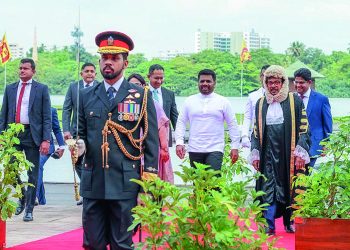On the 4th of this month Sri Lanka begins the 50th year after independence from British rule. It also marks Sri Lanka’s 50th year as a free country, after nearly 500 years of foreign rule.
The past forty nine years saw dramatic changes take place in the country. The former British Colony, once hailed as the ideal democracy in all of post-colonial Asia, has had to face two insurrections in the South. Its democratic credentials have been strongly questioned. It has abandoned the British, inherited a government responsible to an elected parliament, to that of an Executive Presidency with sweeping powers. For nearly half the period since independence the country has seen emergency laws in force. At present, the war of separation waged by Tamil Separatists is in its 14th year. The sweeping constitutional changes promised for this year will, if carried out, make this year the most politically significant since independence.
The generation that saw the birth of independence is fast fading away. Most of those who were engaged in the struggle for independence in diverse ways are no more with us. At the dawn of independence, Ceylon began with great hope. The country had good external reserves as a result of the war, and soon thereafter, the Korean war helped in an economic boom. But, it did not take long for the country to face the harsh reality that the colonial heritage had not prepared us for rapid economic advance. The tardy growth of the economy in the early years, brought about the first change of government in 1956, considered by many to be a watershed in our progress. Welfarist policies were extended, nationalization became a reality and aspects of the then dominant socialist thinking entered our economy.
1977 saw another major change. A government elected with a huge majority began to abandon the policies of socialism which had been grafted to the economic system, which had in fact not changed very much from the colonial patterns of the past With the pre-independence unity among the island’s different ethnic groups almost shattered, and always at the mercy of the world market. Sri Lanka watched helplessly as she saw other countries in Asia forge ahead. The best example was Singapore, where Lee Kwan Yew who led the city state into independence, declared his immediate goal as achieving within ten years, the progress that Ceylon had achieved at the time an independent Singapore was born.
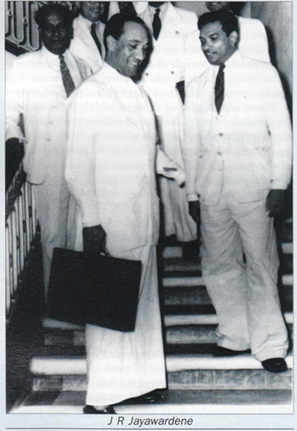
Many are the reasons adduced for the state of the economy of Sri Lanka today. Some blame the World Bank and the IMF; others blame the intrusion of socialist policies since 1956; many blame the lack of political honesty among those who held the reins of power, there is also the charge that the type of democracy we inherited was one which required the pandering to short term political gains and not long term economic goals. Whatever the reasons, Sri Lanka lies very near the bottom in all charts that measure economic success in the world and in our region. There are signs that long-needed corrective measures are being taken, but whether they are sufficient for the needs of today and the immediate future are a matter of genuine concern and debate.
In this context, at the beginning of this 50th year of independence Business Today thought it useful to take an overview of the economy of Sri Lanka from 1948 to this day, and bow we should face the challenges of the future. We thought that a good approach would be to ask some of the most experienced and qualified persons who have seen the economic transformation of this country over the past 49 years. So we present here the views of NU Jayawardena, the first Sri Lankan Governor of the Central Bank and one of the most dynamic businessmen of the years under review, Dr Gamani Corea, the former Secretary General of UNCTAD one of the most authoritative and respected voices on the subject of Third World Economies.
World Economics, and A S Jayawardana, the present Governor of the Central Bank. Adding to the interest are excerpts from the first Budget Speech of Independent ceylon made by its first Finance Minister, the late JR Jayewardene in 1918. and some aspects of the criticism of that Budget by Dr NM Perera, at that time the leader of the LSSP, who later became a Finance Minister, and was always considered an important critic of the economic policy.
This is how JR Jayewardene. Minister of Finance, began presenting the historic first Budget Proposals of independent Ceylon on July 20, 1948. “It is my proud privilege to place before you the Estimates of Expenditure and the Revenue proposals to meet that expenditure, for the financial year 1948-49. After 400 years the power to fashion the future of our Motherland has come once again to our own hands. To us, therefore, who are entrusted with the responsibility of governing, must be apportioned praise or blame for the manner in which we perform that task. Immediate results may not flow from our decisions, but we can lay down the general lines of progress and prepare the foundations on which the future edifice of a free, democratic and contented Ceylon can be built.
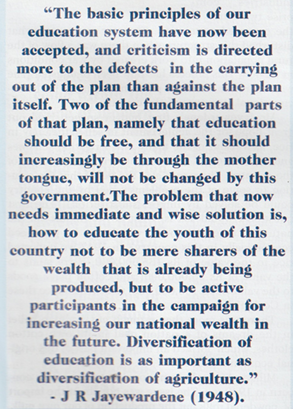
Jayawardene’s main claim was that his was the first Budget which had a plan for the development of the economy and the country. He had some reasons to be optimistic about the future. As he explained it. we were well ahead. “The per capita income of Ceylon in relation to the countries of South East Asia, is second only to that of Japan, and exceeds that of the Philippines, India, Pakistan. Indonesia, China, Malaya and Burma. The economic survey carried out by the United Nations Economic Commission of Asia and the Far East emphasises this fact, and gives other comparative data which are of great interest to the people of Ceylon.
Here is how he explained the realities of that day: “Let us enquire for a moment as to how this income is earned. In 1947, tea, rubber and coconut produced an income of Rs 807,000,000 and other experts Rs 85,000,000 The income from the production of goods. retained, services etc., was Rs 1,167,000,000 The important point I wish to emphasise here is the dependence of our national economy on our exports, and that too almost entirely on the exports of tea, rubber and coconut products which account for 20 percent of the export trade. According to the 1946 census, the total population of the Island Was almost
6,700,000,00..It would be a correct estimate. therefore, to say that 63.4 percent of the population earn a living from agriculture, 11.9 percent from industries. 11.3 percent from trade and transport, 3.3 percent from the Public Services and the liberal arts, and 18 percent from fishing. Those employed in trade and other businesses connected with the production, distribution and export prise two-thirds of the occupied population. The war years somewhat disturbed this structure when there was a flow of the rural population into work created by war conditions in Ceylon. This process has now been readjusted. The war, therefore, made no permanent change in the occupational structure of the country.
Mr Jayewardene’s first budget speech held out great hope for the achievement of selfsufficiency in rice, as a result of the many new irrigation schemes and restoration of the ancient irrigation systems of the country. There was also the belief that the solution to some of the problems faced by the country could be solved by import substitution. The first question I would ask is: what do we import in the nature of essential goods, which can be produced economically in this country? In 1947 we imported rice to the value of Rs 135,000; curry, stuffs to the value of Rs 28,000,000, and cotton piece goods to the value of Rs 100,000,000 Can we produce these in Ceylon?”
There was more than a touch of Gandhian belief in the dreams of a nation clad in its own cotton clothes, which formed an important part of this original economic plan.
Milk and its role in national nutrition was a concern in 1948 too. The issue was not about the import of powdered milk but the production of our own milk.
As Mr Jayewardene explained, “The number of meat cattle of all varieties, according to the latest Census is 1.2 million, and is far below our normal essential requirements. Our normal consumption of milk is 1.7 ounces of milk per head per day, which is the lowest in the world, even lower than in India. A consumption of at least 5 ounces is prescribed to be necessary for a minimum standard of living. We have therefore to increase the production of milk from 23 million gallons a year to about 70 million gallons a year as the minimum standard of production, below which we cannot go without serious consequences to the health of the population.”
That first budget of independent Sri Lanka was one of modest expectations, but one which highlighted the problems the country faced, as it emerged from colonial rule. It dealt with social services, apportioned a considerable sum to subsidies on food, health and education. It dealt with at great length on the importance of power generation for the tasks of development. It boasted of the investments being made on the Laxapana project, with Norton Bridge and Castlereigh both to produce a total of 50,000 Kw It was a budget which tried to marry the welfare state policies of Britain of that day, with the Gandhian policies of self-sufficiency, and the need to help the private sector to engage in development under the guidance, assistance and control of the Government.
Here is how Mr Jayewardene ended his speech. “I have outlined the programme that this government seeks to implement during the course of the next 6 years….. We have decided to march realistically, democratically, and philosophically towards a logically defined goal. What nobler goal can we have, can anyone have, than that of raising the standard of living of our people, which, though ahead of many countries in Asia, is still deplorably behind the civilized standards reached by those who were free while we remained in bondage? We have not presented you with a plan which has no relation to the actual facts of the problems that face us. We do not promise as our economic objective a comfortable feather bed for all. … Yet, the difficulties and obstacles in the way, will not deter us from a steady advance along the path we have chosen. Remember, that at long last we have risen again. The Present and the Future is ours, to shape, to mould to our heart’s desire: to make or to mar….We have deliberately decided
to alter the broad framework of our social and economic structure and to do so only by the exercise of the legitimate powers that democracy has vested in us, without fear or favour, affection or ill-will.
And finally, we do not seek a solution to our problems in the context of Western economic theories alone….Material wealth and comfort did not attract us completely. Our philosophy stressed the development of the human mind rather than mere acquisition of worldly riches. Let us then, ‘Be lamps unto ourselves’. Hold fast to the Truth as a lamp. Hold fast as a refuge to the Truth. Look not for refuge to anyone beyond ourselves.”
Here are gleanings from what Dr NM Perera, then Leader of the Opposition and the Trotskyite Lanka Sama Samaja Party (LSSP), had to say of the first budget of independent Ceylon.
“The Minister of Finance appeared to be conscious that the spirits of the departed great were hovering around him. He talked in terms of the comming generations -“generations yet unborn” This Budget, apparently, is framed for the benefit of the generations, the millions yet to be born in this country. The present generation, apparently, can look after itself.
There is at least one thing that can be said for this Budget it will to down in history as the Budget
that gave the greatest possible measure of relief to that vast array of plutocrats, we find in this country, some of whom I saw on occasion seated there listening to the Minister of Finance in fearful anticipation of
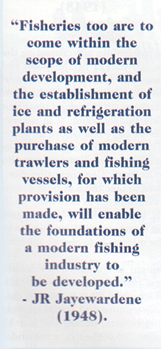
‘the doom’ that to be pronounced on them.” Dr Perera quoted extensively from the past Budgets presented from 1943, to show that the first Budget of independent Ceylon, was infact no different from what
was promised earlier and achieved, especially in the areas of self-sufficiency in rice, alleviation of poverty and the supply of cheap or subsidised food for the masses. He was critical on the emphasis laid on the movement of the poor and landless to the Dry Zone, while leaving the comparatively better developed Wet Zone areas to the rich.
“I think I have quoted enough to make it clear that what we have today is a Budget which is in no way different to the Budgets we have had before us in the past. The same words have been used before such as “planning”, “co-ordinated”, and ‘we are trying to do this, we are trying to do that’. Can they, therefore, blame us now if we refuse to take them at their words. in the same way that they refused to take their predecessors at their words, because for the last 16 years we have seen this thing being repeated over and over again, and nothing done materially to change the lives of the people.
Referring to investment in colonization schemes Dr Perera said: “He has plans in regard to the various major colonization schemes. What is the total that the Hon.Minister of Agriculture and Lands expects to cultivate? According to him, during the last 12 years, they have brought 200,000 extra acres under extra cultivation. At the present moment we have about 900,000 acres 912 acres to be more accurate under paddy, and there are another 82,000 acres to be brought under cultivation, which will make 1,000,000 acres which will be under paddy. Will that make us self-sufficient within the next six years? No. Then, what is the purpose of this plan, Mr Speaker? What is the goal you are aiming at?
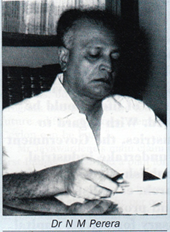
These were his views on the government’s plans as stated in the Budget to have import restrictions for the development of local industry: “it has not been possible for the Hon. Minister of Finance to talk a word about the financial implications of any of these industrial proposals. We do not know what the textile industry that they hope to set up, and the salt industry that they are going to set up, would cost. What is the cost per unit of article produced? Can that stand possible competition from outside?
It would be a thoroughly short-sighted policy for this Government to restrict itself, to confine this Island, to a completely isolated economy by building a huge tariff wall or by putting up huge embargoes on the various products that they might get from the rest of the world. Do they seriously hope that other countries are going to buy all you have to export, while you don’t import anything at all? This is economics of the medieval age.” Commenting on the impact of international forces Dr Perera said: “There is no reference in this budget to the repercussions in this country of the International Trade Agreement, under which certain alterations are to be made in tariff duties in the U. S. A. I see no reference in the Budget speech to the reciprocal advantages we are to give the American Government. None of these matters are mentioned in the speech of the Minister of Finance
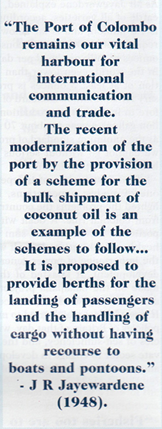
Hon. Members must realize that we cannot afford to live isolated from the rest of the world, though airy suggestions may be made that we should establish factories to produce this, that and the other thing, to produce steel and various other articles.”
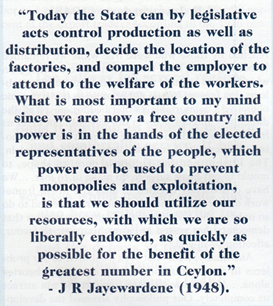
In conclusion of his observations Dr Perera said: “This Budget provides for no real advancement, no real improvement, in the position of the workers of this country, its peasants. This Budget provides for no increase in the living standards of the masses of this country, no betterment in their living conditions: provides for no amelioration of the hard circumstances in which they are living today. Such a Budget cannot be accepted by members of the Opposition.”


